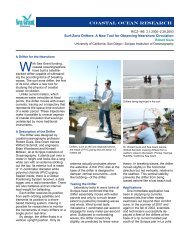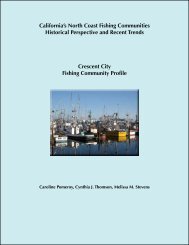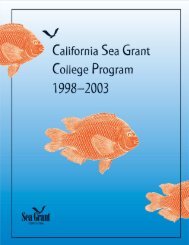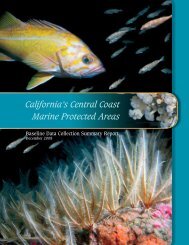2001â2002 - California Sea Grant - UC San Diego
2001â2002 - California Sea Grant - UC San Diego
2001â2002 - California Sea Grant - UC San Diego
You also want an ePaper? Increase the reach of your titles
YUMPU automatically turns print PDFs into web optimized ePapers that Google loves.
Withering Abalone Disease Spreads to Northern <strong>California</strong><br />
During the last fierce El Niño in 1997–98, a deadly disease<br />
swept through <strong>California</strong>’s abalone farms, destroying $1.5<br />
million worth of abalone at the state’s two largest farms. Despite<br />
a return to normally cool ocean water temperatures, this same lethal<br />
disease appears to be marching north, into waters once thought to be safe<br />
havens for both wild and farmed abalone, according to a recent <strong>Sea</strong> <strong>Grant</strong><br />
project led by professor Carolyn Friedman of the University of Washington<br />
in <strong>Sea</strong>ttle. At the time of the study, Friedman was a senior fish pathologist<br />
with the <strong>California</strong> Department of Fish and Game and researcher<br />
at the University of <strong>California</strong> at Davis.<br />
The apparent spread of withering syndrome, Friedman says, raises<br />
concerns that another warm water event, such as another strong El Niño,<br />
could trigger an outbreak in beds north of <strong>San</strong> Francisco, home of the last<br />
healthy remnant abalone populations in the state and the only areas still<br />
open to recreational abalone diving.<br />
Based on a 1999–2000 survey of beds in Central and Northern <strong>California</strong>,<br />
the bacterium that causes withering syndrome has reached as far as<br />
Van Damme State Park in Mendocino County and Crescent City near the<br />
Oregon border, the northernmost extent of the bacterium on record. None<br />
of the abalone from these two survey sites showed clinical signs of disease,<br />
but the mere fact that they harbor the infectious bacterium means that<br />
environmental stress—lack of food or balmy seawater—sets the stage for<br />
full-blown disease. The disease has already moved as far north as Point<br />
<strong>San</strong> Pedro in Pacifica. The northernmost extent of the disease previously<br />
was Cayucos Point in <strong>San</strong> Luis Obispo.<br />
Withering syndrome is a lethal rickettsial-like infection caused by the<br />
bacterium Candidatus Xenohaliotis californiensis. Through a mechanism<br />
not yet fully understood, the bacterium attacks the lining of an abalone’s<br />
digestive track, obstructing the production of digestive enzymes. Unable to<br />
digest what it has ingested, an abalone catabolizes, or consumes, its own<br />
foot muscle, hence the disease’s name. Even while an abalone slowly<br />
starves, it continues to spread the bacterium via its feces. Wild abalone<br />
can thus spread<br />
disease to abalone<br />
farms circulating<br />
seawater through<br />
their tanks.<br />
Hundreds of<br />
thousands of abalone<br />
were destroyed or<br />
killed because of<br />
withering syndrome<br />
during the 1997–98<br />
El Niño. It and<br />
another infection,<br />
caused by a South<br />
The abalone specimen on the left has withering<br />
disease. Note the severe atrophy, or withering, of its foot<br />
muscle. The specimen on the right is healthy. Photo:<br />
<strong>California</strong> Department of Fish and Game<br />
African worm, led to a dramatic drop in production; from 292,000<br />
pounds in 1996 to 162,000 pounds in 1998. Production is still below its<br />
1996 peak. In 2001, about 230,000 pounds were harvested, worth $3.6–<br />
$4 million.<br />
The bacterium’s newfound presence in northern waters also poses a<br />
threat to the health of wild beds. An epidemic in the 1980s decimated<br />
black abalone beds throughout Central <strong>California</strong>, with mortality rates<br />
hitting 99 percent in some areas. The combination of disease and severe<br />
over harvesting of the state’s seven native abalone species eventually led<br />
to a moratorium on all commercial abalone fishing and, because stocks do<br />
not appear to be reviving, to progressively stricter limits on recreational<br />
abalone diving.<br />
What has caused the bacterium’s spread is unknown; but, Friedman<br />
said, outplantings or aquaculture might be to blame. Both Crescent City<br />
and Van Damme received outplantings of abalone seed, a well-intentioned<br />
effort to rebuild depleted beds carried out before scientists discovered<br />
the disease is caused by a water-borne bacterium. Crescent City is<br />
near an outfall for an abalone farm.<br />
8











